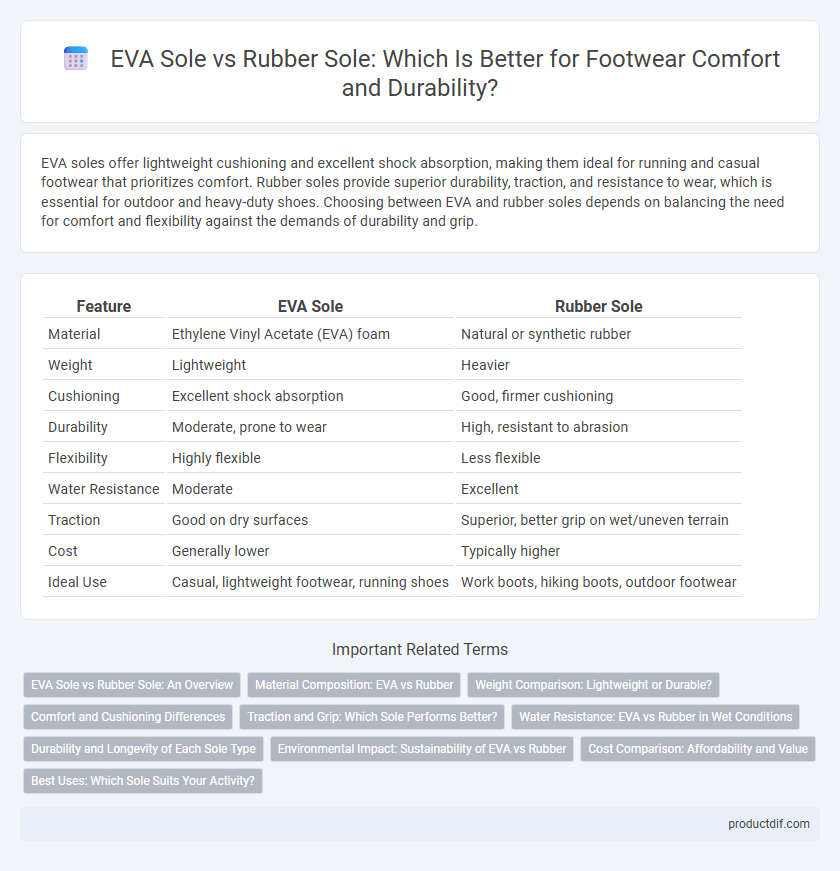EVA soles offer lightweight cushioning and excellent shock absorption, making them ideal for running and casual footwear that prioritizes comfort. Rubber soles provide superior durability, traction, and resistance to wear, which is essential for outdoor and heavy-duty shoes. Choosing between EVA and rubber soles depends on balancing the need for comfort and flexibility against the demands of durability and grip.
Table of Comparison
| Feature | EVA Sole | Rubber Sole |
|---|---|---|
| Material | Ethylene Vinyl Acetate (EVA) foam | Natural or synthetic rubber |
| Weight | Lightweight | Heavier |
| Cushioning | Excellent shock absorption | Good, firmer cushioning |
| Durability | Moderate, prone to wear | High, resistant to abrasion |
| Flexibility | Highly flexible | Less flexible |
| Water Resistance | Moderate | Excellent |
| Traction | Good on dry surfaces | Superior, better grip on wet/uneven terrain |
| Cost | Generally lower | Typically higher |
| Ideal Use | Casual, lightweight footwear, running shoes | Work boots, hiking boots, outdoor footwear |
EVA Sole vs Rubber Sole: An Overview
EVA sole offers lightweight cushioning and superior shock absorption compared to rubber sole, making it ideal for athletic and casual footwear. Rubber sole provides enhanced durability, grip, and slip resistance, favored in work boots and outdoor shoes. Both materials have unique advantages that influence comfort, performance, and longevity based on shoe type and intended use.
Material Composition: EVA vs Rubber
EVA sole is made from ethylene-vinyl acetate, a lightweight, flexible, and cushioning material that provides excellent shock absorption and comfort. Rubber sole, composed of natural or synthetic rubber polymers, offers superior durability, slip resistance, and abrasion resistance for enhanced traction. The choice between EVA and rubber soles depends on the need for lightweight cushioning versus robust durability in footwear performance.
Weight Comparison: Lightweight or Durable?
EVA soles are significantly lighter than rubber soles, providing enhanced comfort and reduced foot fatigue, especially beneficial for athletic and casual footwear. Rubber soles offer superior durability and traction, making them ideal for heavy-duty use and outdoor activities where wear resistance is crucial. Choosing between EVA and rubber soles depends on whether weight savings or lasting durability is the priority for the intended footwear application.
Comfort and Cushioning Differences
EVA soles provide superior cushioning due to their lightweight, flexible foam composition, which absorbs impact effectively for enhanced comfort during prolonged wear. Rubber soles offer better durability and traction but tend to be heavier, resulting in less shock absorption and a firmer feel underfoot. Choosing between EVA and rubber soles depends on prioritizing lightweight comfort or long-lasting support in footwear.
Traction and Grip: Which Sole Performs Better?
EVA soles offer lightweight cushioning but generally provide less traction compared to rubber soles, which excel in grip and durability on diverse surfaces. Rubber soles feature superior slip resistance due to their natural flexibility and tread patterns, making them ideal for footwear requiring strong traction. Choosing between EVA and rubber soles depends on the activity's demand for grip, with rubber soles outperforming in most traction-critical conditions.
Water Resistance: EVA vs Rubber in Wet Conditions
EVA soles offer excellent water resistance due to their closed-cell structure, preventing water absorption and making them lightweight and quick-drying. Rubber soles, while also water-resistant, provide superior traction and durability in wet conditions but tend to be heavier and less breathable. Choosing between EVA and rubber depends on the need for lightweight comfort versus enhanced grip and longevity in wet environments.
Durability and Longevity of Each Sole Type
EVA soles offer lightweight cushioning and shock absorption but tend to wear out faster due to lower abrasion resistance, making them less durable for heavy or prolonged use. Rubber soles provide superior durability and longevity, with excellent resistance to wear, harsh terrains, and environmental factors, ideal for rugged or outdoor footwear. The choice between EVA and rubber soles depends on the intended use, prioritizing comfort and lightness versus extended lifespan and toughness.
Environmental Impact: Sustainability of EVA vs Rubber
EVA soles are lightweight and offer better recyclability compared to traditional rubber soles, reducing environmental footprint through lower resource consumption and easier disposal. Rubber soles, derived from natural or synthetic sources, can have higher carbon emissions during production, though natural rubber is renewable and biodegradable under proper conditions. Opting for sustainably sourced natural rubber or recycled EVA materials enhances eco-friendly footwear choices by minimizing waste and promoting circular economy principles.
Cost Comparison: Affordability and Value
EVA soles are generally more affordable than rubber soles due to lower material and manufacturing costs, making them a cost-effective choice for budget-conscious consumers. Rubber soles, while pricier, offer enhanced durability and traction, providing greater long-term value for active or rugged use. Balancing initial affordability with lifespan performance is crucial when choosing between EVA and rubber soles for footwear.
Best Uses: Which Sole Suits Your Activity?
EVA soles provide lightweight cushioning and superior shock absorption, making them ideal for running, walking, and casual wear where comfort and flexibility are priorities. Rubber soles offer enhanced durability, slip resistance, and robust traction, suited for hiking, work boots, and outdoor activities requiring rugged grip and long-lasting performance. Choosing between EVA and rubber soles depends on activity intensity, terrain, and the need for cushioning versus durability.
EVA Sole vs Rubber Sole Infographic

 productdif.com
productdif.com